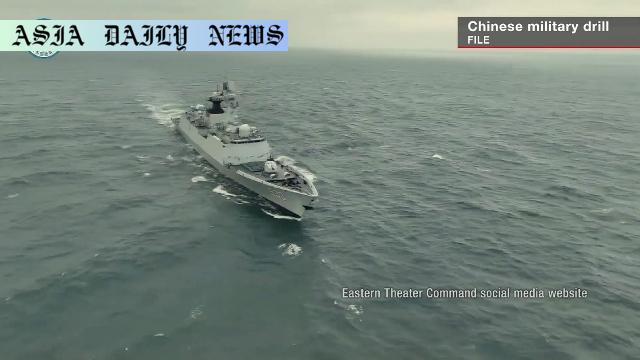Taiwan Drills: China’s military conducts joint exercises involving army, navy, air, and rocket forces around Taiwan, showcasing readiness.
- China’s military conducts joint army, navy, air, and rocket force drills around Taiwan.
- Exercises include blockading key areas to test operational readiness.
- The drills aim to deter Taiwanese independence efforts and assure sovereignty.
- Activities serve as a warning to Taiwan’s government and the US.

China’s Strategic Bend on Taiwan: A Military Exercise Update
China’s military activities around Taiwan have garnered widespread attention as tensions escalate over Taiwan’s independent status. On Tuesday, the Eastern Theater Command of the Chinese military issued an announcement revealing that their forces are engaged in multi-directional exercises around Taiwan. These drills, encompassing the army, navy, air, and rocket forces, mark a significant demonstration of China’s military capability and resolve. This latest wave of operations signals China’s intent to solidify its territorial claims and maintain its sovereignty.
The exercises focus on a variety of strategic operations, including blockading key maritime and aerial points around Taiwan. According to the military, these operations will test the interoperability of different military branches and assess their combat readiness. More notably, China’s messaging is clear: these actions are directed at Taiwan’s leadership, particularly the Democratic Progressive Party, to curb what it perceives as pro-independence behavior. Besides Taiwan, the United States—a known ally of Taiwan—is also indirectly addressed through this military posturing, signaling China’s growing unease at Western involvement in the region.
Testing Combat Preparedness and Sending a Strong Signal
The drills, which include both maritime and aerial patrols, are designed to test how China’s forces can catalyze cooperation between various divisions. This is not the first time China has conducted such operations—similar exercises occurred last month as part of Beijing’s consistent attempts to normalize military presence around Taiwan. The Chinese military has emphasized that these exercises are both lawful and necessary actions to fortify national unity and sovereignty. The exercises are also an overt warning to Taiwanese President Lai Ching-te’s administration, signaling that China will not tolerate moves toward independence.
Observers have noted the dual purpose of these exercises. On the one hand, they present a clear warning to the US against continued support for Taiwan. On the other, they are aimed at showcasing Beijing’s military advancements. The simultaneous targeting of key sea lanes and surrounding regions exemplifies a well-coordinated effort to assert control, with the Eastern Theater Command making its operations seem routine. Such actions are calibrated to send a psychological and structural reminder to both Taiwan and any external powers.
Broader Implications for the Region and Beyond
China’s military maneuvers extend well beyond Taiwan and its immediate vicinity. These drills are a testament to China’s growing assertiveness in the Indo-Pacific region. By conducting high-profile exercises, the Chinese government hopes to bolster domestic support and demonstrate to its citizens and international audiences alike that it is taking a tough stance in safeguarding its national interests. Amidst an increasingly volatile geopolitical climate, the implications of China’s military drills could stretch far, straining relationships with regional actors such as Japan, South Korea, and the ASEAN nations.
Crucially, the message to Taiwan is clear: Beijing is watching closely and is willing to take actionable measures to counteract any calls for independence. For governments watching from the sidelines, including the US, the drills also serve as a stark reminder that China’s strategic aspirations remain firmly entrenched. Cooperation and diplomacy in the region are likely to face new challenges as China’s show of force prompts future responses and counterstrategies from surrounding nations.



Commentary
China’s Military Strategy: A Show of Strength or a Strategic Warning?
China’s recent military drills around Taiwan reflect a meticulously planned and strongly executed foreign policy approach aimed at reinforcing its territorial claim over Taiwan. Setting aside the political context for a moment, the sheer scale of these exercises underscores an insistence on modernizing and enhancing combat capabilities. The concept of ‘combat readiness’ isn’t new, but this implementation sends a stern and multifaceted message to all parties observing this situation.
Notably, these maneuvers spotlight a larger narrative centered on Taiwan’s independence movement, which Beijing views as an existential threat. President Lai Ching-te has been the focal point of China’s diplomatic and military response. Labeling Taiwan’s ruling Democratic Progressive Party as pro-independence allows China to frame these drills as preventative measures rather than pre-emptive aggression. However, critics often point out that such displays deepen tensions rather than alleviate them—potentially drawing the region into an arms race rather than cooperation.
The Domino Effect: Regional and International Implications
The message to the United States, however subtle, is also unmistakable. As an ally to Taiwan, consistently arming and supporting its democratic governance, the US finds itself in an awkward position. On one hand, it must respond with strategic neutrality; on the other, it has to ensure Taiwan’s sovereignty remains protected as per its commitments. China, meanwhile, maneuvers with unparalleled confidence, exercising its regional dominance to challenge Western involvement. These geopolitical chess moves will likely have ripple effects, restructuring alliances and reactions globally.
Ultimately, China’s unwavering focus on Taiwan, underscored by such broad-scale military maneuvers, serves as both an internal consolidation of power and an external statement of influence. The degree to which this strategy proves effective will rest upon the responses of Taiwan, neighboring countries, and the broader international community. As spectators and stakeholders observe these developments, one cannot help but wonder: does this tactical bravado secure peace and unity for China, or possibly lay the groundwork for unmanageable conflict?